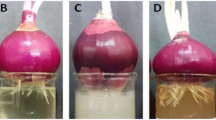Abstract
Anin vitro cytotoxicity screening of theTyphonium flagelliforme extracts indicated high cytotoxicity effect on human lung carcinoma NCl-H23 cells and human mammary gland carcinoma T-47D cells, but the extracts were not active on human liver carcinoma HepG2 cells. NCl-H23 cells were more susceptible toT. flagelliforme extracts than T-47D cells. EDP50 values of the hexane fractions of the mature plant and thein vitro plantlet ofT. flagelliforme on NCl-H23 cells were less than 2 μg/mL Extract from the mature plant was relatively more cytotoxic than the one fromin vitro plantlet except for the hexane fraction. The chloroform and butanol fraction of the mature plant had higher cytotoxicity effect than the fraction fromin vitro plantlet on NCl-H23 cells. All the 3 fractions (hexane, chloroform, and butanol) of the mature plant exhibited higher cytotoxicity effects on human mammary gland carcinoma T-47D cells than the 3 fractions ofin vitro plantlet. However, the human liver carcinoma cells were resistant toT. flagelliforme extracts except for higher concentration of hexane fractions of both the mature and thein vitro plants and the chloroform fraction of the mature plant. Micropropagated plantlets ofT. flagelliforme could hence be used as herbal materials for the treatment of human lung and breast cancers.
Similar content being viewed by others
Abbreviations
- IBA:
-
indole-3-butyric acid
- MS:
-
Murashige and Skoog
- BA:
-
N6-benzyladenine
Literature Cited
Choo CY, Chan KL, Sam TW, Hitotsuyanagi Y, Takeya K (2001) The cytotoxicity chemical constituents of the hexane fraction ofTyphonium flagelliforme (Araceae). J Ethnopharmacol 77: 129–131
Colman de Saizarbitoria T, Anderson JE, Alfonso D, McLaughlin JL (1997) Bioactive furonaphtoquinones fromTabebuia barbata (Bignoniaceae). Acta Cient Venez 48: 42–46
Dennis C (2001) Antioxidant studies onTyphonium flagelliforme (mother plant),T flagelliforme (in vitro) andAndrographis paniculata (mother plant). Thesis of Applied Science Degree. Universiti Sains, Penang
Geran Rl, Greenberg NH, Macdonald MM (1972) Protocols for screening chemical agents and natural products against animal tumours and other biological systems. Cancer Chem Rep 3: 1–87
Goh SH, Soepadmo E, Chuah CH (1993) Phytochemical guide to Malaysia flora. Institute of advanced studies, University of Malaya, Kuala Lumpur
Hamburger M, Hostettmann K (1991) Bioactivity in plants: the link between phytochemistry and medicine. Phytochem 30: 3864–3874
Hay A (1993) The genusTyphonium (Araceae-areae) in Australia. Blumea 37: 345–376
Ho CK, Chan CC (2003) Moscatilin from the orchidDendrobrium loddigesii is a potential anticancer agent. Cancer Invest 21: 729–736
Hostettmann K, Marston A (1995) Saponins. Cambridge University Press, London
Itokawa H, Takaya K (1993) A review of antitumor substances from higher plants. Heterocycles 35: 1467
Koh WY, Chan LK (2003) Micropropagation ofTyphonium flagelliforme in immersion cultures. J Trap Med Plants 4: 91–96
Li J, Liang N, Mo L, Zhang X, He C (1998) Comparison of the cytotoxicity of five constituents fromPteris semipinnata L.in vitro and the analysis of their structure-activity relationships. Yao Xue Xue Bao 33: 641–644 (article in Chinese)
Murashige T, Skoog F (1962) A revised medium for rapid growth and bioassays with tobacco tissue cultures. Physiol Plant 15: 473–497
Neoh CK (1992)Typhonium divaricatum (rodent tubers): A promising local plant in the fight against cancer. Med J Malaysia 47: 86–88
Ong BP (1996) Micropropagation and bioactivities study ofTyphonium flagelliforme. Thesis of Applied Science Degree. Univeristi Sains, Penang
Perry MR Metzger J (1980) Medicinal Plants of East and Southeast Asia: Attributed Properties and Uses. MIT Press, London, pp 39
Su TS, Chan LK, Pargini N, Teo CKH (2000)In vitro propagation ofTyphonium flagelliforme (Lodd) Blumea.In Vitro Cell Dev Biol 36: 402–406
Tan ML (2003) Cytotoxicity and cell death mechanisms ofEpipremnum pinnatum (L.) Engl, extracts in T-47D, a breast carcinoma cell line. Ph.D. thesis, Universiti Sains, Penang
Teo CKH, Chng Bl (1996) Cancer: Yet they livel Eramaps Sdn Bhd, Malaysia, pp 53–70
Thilakavathy K, Maznah I, Asmah R, Siti MM, Asmah Y, Fauziah O (1999) The Effect ofTyphonium divaricatum extract on the plasma gamma-glutamyl transpeptidase and the histology of induced hepatocarcinogenesis rat liver.In Z Zakaria, Nl Yusoff, IM Said, LB Din, eds, Interdisciplinary Approaches in Natural Product Sciences. The Malaysian Natural Products Society, Kuala Lumpur, pp 157–163
Yamazaki S, Onishi E, Enami K, Kohase M, Sakamoto H, Tanouchi M, Hayashi H (1986) Proposal of standardized methods and reference for assaying recombinant human tumour necrosis factor. Jap J Med Sci Biol 39: 105–118
Author information
Authors and Affiliations
Corresponding author
Rights and permissions
About this article
Cite this article
Chan, L.K., Koh, W.Y. & Tengku-Muhammad, T.S. Comparison of cytotoxic activities betweenin vitro and field grown plants ofTyphonium flagelliforme (Lodd.) blume. J. Plant Biol. 48, 25–31 (2005). https://doi.org/10.1007/BF03030561
Received:
Accepted:
Issue Date:
DOI: https://doi.org/10.1007/BF03030561




